- About us»
- Net income calculator»
- Population aging»
-
- Least developed regions»
-
- Average wage
- Material need benefits
- Meal allowance
- Counties of Slovakia
- Inflation
- Living and Subsistence Minimum
- Unemployment of Czechia and Slovakia
- NACE Classification
-
- Life expectancy
- Gender differences
- Youth unemployment and NEET
- Minimum wage in EU
- Unemployment rates of different age groups
- Share of salaries on GDP
- Employment rate
- NEET
- Long term unemployment
- Percentage of employees ususally working at nights
- Unemployment rate
-
- Bratislava and surroundings
- Kopanice
- Danube river
- lower Vah river
- middle Vár river
- upper Nitra river
- lower Nitra river
- Mining cities
- Kysuce a Orava
- upper Vah river - Liptov
- Spiš cities
- upper Hron river
- Juhoslovenská kotlina
- Košice fold and Torysa river
- upper Zemplín
- lower Zemplín
- EU regions
- NUTS3 regions of Slovakia
- LAU1 dataset
-
- Projects and activities
- Inclusive growth»
- Good work
- Project SKRS
- Social system – reality and vision
- Library
-
- Education of unemployed
- Young unemployed not taking part in education
- Proposal to change the system of education funding
- News»
- Contact
Bulgaria – BG
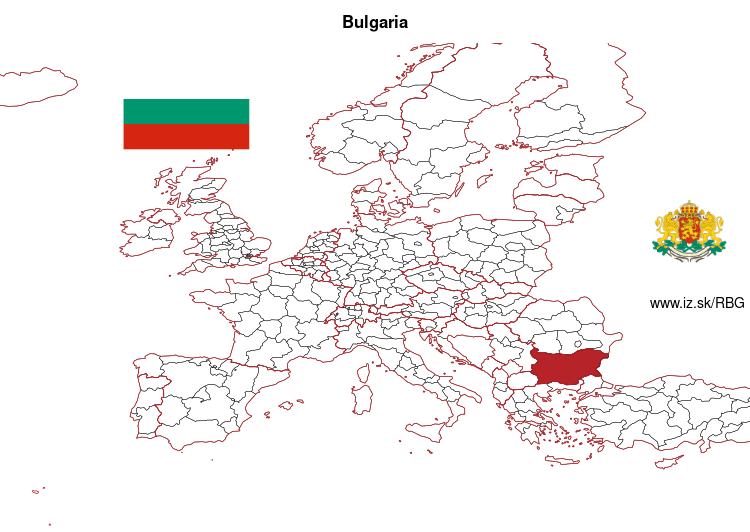
More on wikipedia wikidata Q219 on OpenStreetMap Bulgaria slovensky: BG
Subregions: Northern and Eastern Bulgaria, South-Western and South-Central Bulgaria
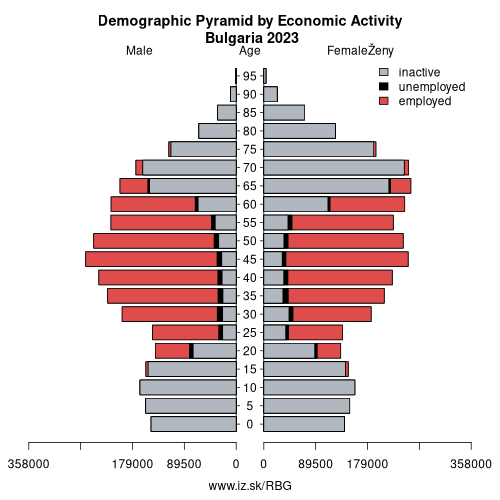
Unemployment
| Indicator | Period | Value |
|---|---|---|
| Unemployment | ||
| unemployment rate | 2025q3 | 3.5 |
| youth unemployment rate | 2024 | 12.3 |
| unemployment rate of low educated people | 2025q3 | 9.6 |
| Long term unemployment | ||
| long term unemployment | 2025q3 | 1.4 |
| share of long term unemployed | 2025q3 | 36 |
Composition of population according to age group, education and economic activity, Bulgaria
| Age group | Low education | Middle education | High education |
|---|---|---|---|
| Y20-29 | P: 68.1 E: 27.0; U: 5.6; I: 35.5 | P: 354.8 E: 178.2; U: 13.6; I: 163.0 | P: 124.5 E: 101.1; U: 4.2; I: 19.2 |
| Y30-39 | P: 116.9 E: 58.7; U: 9.8; I: 48.4 | P: 398.3 E: 332.9; U: 18.3; I: 47.1 | P: 285.4 E: 263.6; U: 6.3; I: 15.5 |
| Y40-49 | P: 146.9 E: 85.6; U: 10.9; I: 50.4 | P: 509.2 E: 447.8; U: 13.9; I: 47.5 | P: 304.9 E: 289.8; U: 4.7; I: 10.4 |
| Y50-59 | P: 130.0 E: 69.0; U: 9.9; I: 51.1 | P: 544.0 E: 454.0; U: 16.5; I: 73.5 | P: 249.2 E: 231.4; U: 2.9; I: 14.9 |
| Y60-69 | P: 166.6 E: 37.3; U: 4.6; I: 124.7 | P: 546.3 E: 217.4; U: 5.8; I: 323.1 | P: 194.4 E: 102.0; U: 1.0; I: 91.4 |
Note: in thousands in 2023, according to labour force sample survey. P – total population, E – employed, U – unemployed, I – number of economically inactive
Demographics
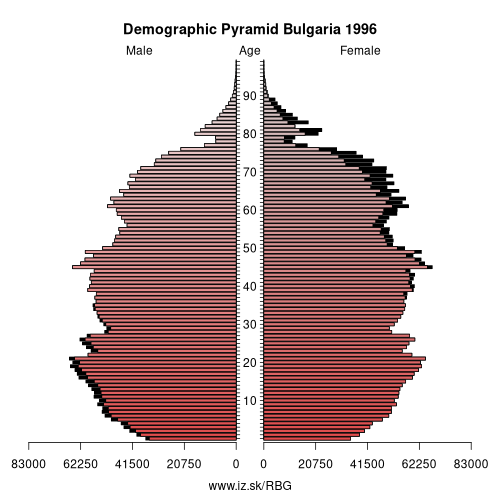
| Indicator | Period | Value |
|---|---|---|
| Demographics | ||
| number of inhabitants | 2024 | 6 445 481 |
| population density | 2023 | 58.6 |
| old-age dependency ratio | 2024 | 38.2 |
| Population ageing | ||
| unemployment rate – over 55 years | 2025q3 | 2.5 |
| aggregate replacement ratio | 2024 | 0.44 |
| aggregate replacement ratio – females | 2024 | 0.45 |
| life expectancy of a 50 year old | 2023 | 28.4 |
| healty life expectancy at 50 years | 2023 | 22 |
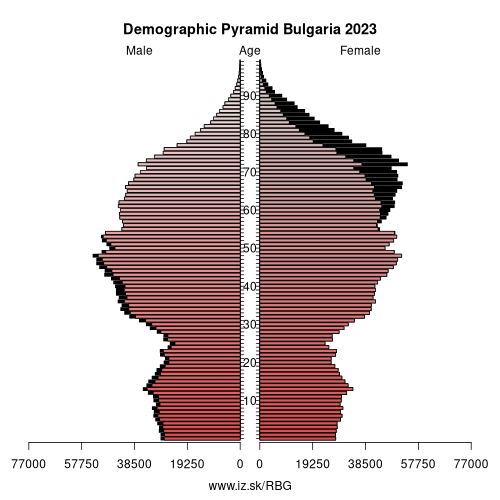
Employment by sectors, Bulgaria
| NACE r2 | % | NACE r2 | % | ||
|---|---|---|---|---|---|
| A | 141.9 | 5% | B-E | 587.7 | 20% |
| F | 236.4 | 8% | G-I | 853.9 | 29% |
| J | 125.2 | 4% | K | 65.4 | 2% |
| L | 18.9 | 1% | M_N | 203 | 7% |
| O-Q | 583.2 | 20% | R-U | 117.4 | 4% |
| TOTAL | 2932.9 | 100% |
Data for the period year 2024. Source of the data is Eurostat, table [lfst_r_lfe2en2].
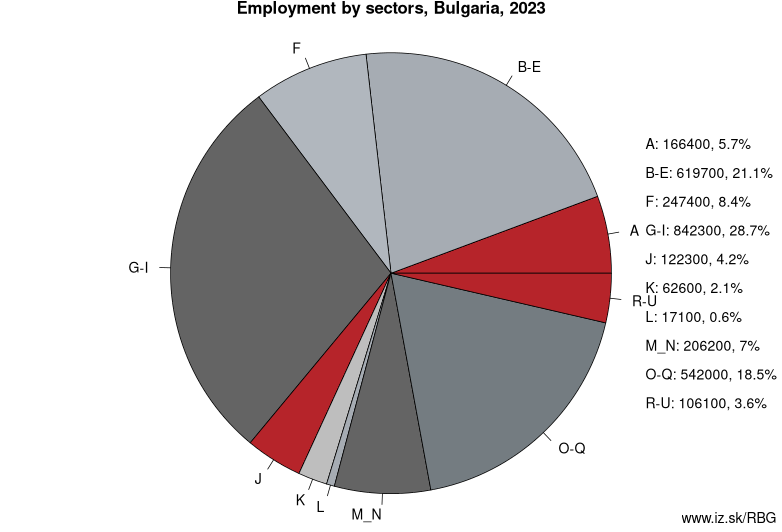
Bulgaria ( (listen); Bulgarian: България, romanized: Bǎlgariya), officially the Republic of Bulgaria (Bulgarian: Република България, tr. Republika Bǎlgariya, IPA: [rɛˈpublikɐ bɐɫˈɡarijɐ]), is a country in Southeast Europe. It is bordered by Romania to the north, Serbia and North Macedonia to the west, Greece and Turkey to the south, and the Black Sea to the east. The capital and largest city is Sofia; other major cities are Plovdiv, Varna and Burgas. With a territory of 110,994 square kilometres (42,855 sq mi), Bulgaria is Europe's 16th-largest country.
One of the earliest societies in the lands of modern-day Bulgaria was the Neolithic Karanovo culture, which dates back to 6,500 BC. In the 6th to 3rd century BC the region was a battleground for Thracians, Persians, Celts and ancient Macedonians; stability came when the Roman Empire conquered the region in AD 45. The Eastern Roman, or Byzantine, Empire lost some of these territories to an invading Bulgar horde in the late 7th century. The Bulgars founded the First Bulgarian Empire in AD 681, which dominated most of the Balkans and significantly influenced Slavic cultures by developing the Cyrillic script. This state lasted until the early 11th century, when Byzantine emperor Basil II conquered and dismantled it. A successful Bulgarian revolt in 1185 established a Second Bulgarian Empire, which reached its apex under Ivan Asen II (1218–1241). After numerous exhausting wars and feudal strife, the Second Bulgarian Empire disintegrated in 1396 and its territories fell under Ottoman rule for nearly five centuries.
Neighbours: Greece, Serbia, Romania, North Macedonia, Turkey
Subregions: Northern and Eastern Bulgaria, South-Western and South-Central Bulgaria
Suggested citation: Michal Páleník: Europe and its regions in numbers - Bulgaria – BG, IZ Bratislava, retrieved from: https://www.iz.sk/PBG, ISBN: 978-80-970204-9-1, DOI:10.5281/zenodo.10200164

 Share
Share Facebook
Facebook Twitter
Twitter News
News